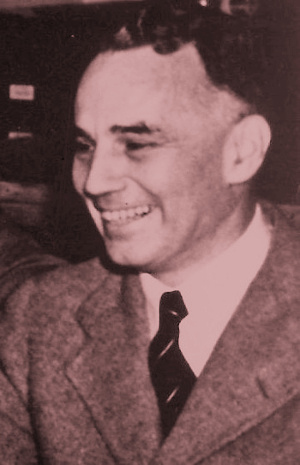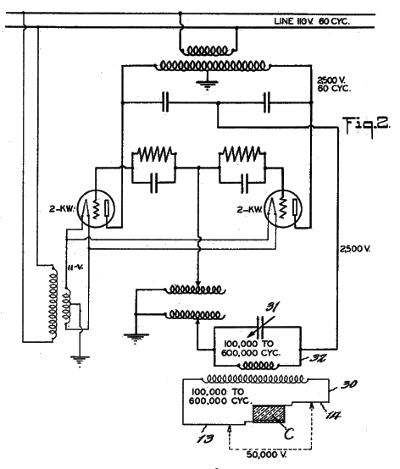Alfred Loomis
February 26, 2018
Laboratory research is interesting, but another enjoyable aspect of working in a large research organization is the company of many interesting
colleagues. Our particular research department had a tradition of
lunching together at our site's
cafeteria. This cafeteria was called "Cafe Alchem," not as any homage to
alchemy, but because our company was originally named
Allied Chemical. There was interesting table conversation about
science, but also occasional lapses into
finance, such as whether to buy
Treasury Bonds or
gold.
My personal opinion is that, unless you're making
integrated circuits, it's never a good time to buy gold. Although we had none at our lunch table, there are
doomsday preppers who keep gold as the only stable
currency in troubled times. It's probably better to invest in sacks of
rice and cartons of
condoms. When you tire of eating rice, you can trade some condoms for
brussels sprouts.
At one point, when the
state lottery had reached a phenomenal payout, we talked about what we would do with all that money. Our
director was a
scientist who had chosen that
career since he really enjoyed doing science. He had an early interest in
rocks and
minerals, so he eventually became a
crystal grower; and, like me, he had a home laboratory in his youth. He said that he would use the lottery winning to build a private laboratory so he could
experiment with whatever caught his interest.
I happened to think of him when I viewed the recent
public television showing of "The American Experience - The Secret of Tuxedo Park."[1] That episode was a
biography of
Alfred Lee Loomis (1887-1975), an unknown
amateur scientist who had enough money to build a world-class scientific laboratory and become an
autodidact scientist of the first order. He was so skilled in
physics that he was a significant contributor to
radar development during
World War II.

Alfred Loomis (1887-1975), on a visit to consider the feasibility of a 184-inch cyclotron at Berkeley, March_29, 1940.
Loomis was unknown to me before I watched his biography on public television. I can be excused for my ignorance, since Loomis disliked publicity of any sort, and his historical footprint is accordingly very small.
(A Wikimedia Commons image, modified for artistic effect.)
His laboratory, at
Tuxedo Park, New York, near
New York City, was funded by his
career as an
investment banker. Born into a family of
social prominence, Loomis was well schooled, attending
Phillips Academy for his
secondary school education, then
Yale University and
Harvard Law School. After his
cum laude graduation from Harvard Law School, Loomis joined the New York law firm,
Winthrop & Stimson, to practice
corporate law. He married
Boston socialite, Elizabeth Farnsworth, in 1912 with whom he had three
sons.
Loomis served in the
US Army during
World War I, reaching the rank of
lieutenant colonel. This
military service changed the course of his life, since he was stationed at the
Aberdeen Proving Ground near
Aberdeen, Maryland and tasked with improvements in
ballistics. At Aberdeen, Loomis invented a device, called the Aberdeen Chronograph, for an improved measurement of the
muzzle velocity of
artillery shells. At Aberdeen, Loomis worked with
Robert W. Wood, a
physicist at nearby
Johns Hopkins University, who inspired his interests in
experimental physics and the use of physical principles for
invention.
Having decided that the practice of law had limited financial rewards, Loomis joined his
brother-in-law, Landon K. Thorne, as investment bankers who specialized in
public utilities with an emphasis on
rural electrification and
consolidation of small electric companies into larger
holding companies. Loomis'
analytical mind
foresaw the
stock market crash of 1929, and he and Thorne cashed-out before crash. After the crash, they were able to acquire
stock in companies at low prices, and Loomis had enough money to build his personal laboratory and enough time for his independent scientific pursuits.
Loomis' wealth allowed him to equip his laboratory in a fashion not possible for other scientists, he did early experiments in
ultrasonics,
electroencephalography, and did considerable experimentation with
radio. Loomis discovered the
K-complex brainwave, which is active during
sleep, in 1937. His
reputation grew to such an extent that his laboratory was visited by such scientific
luminaries as
Niels Bohr,
Albert Einstein,
Enrico Fermi,
James Franck, and
Werner Heisenberg. Loomis helped to secure funding for
Ernest Lawrence in construction of a 184-inch
cyclotron. Eventually, with
World War II on the horizon, Loomis moved his laboratory to
Cambridge, Massachusetts, to work jointly with physicists at the
Massachusetts Institute of Technology.

Fig. 2 from US Patent No. 1,734,975, "Method and apparatus for forming emulsions and the like," by Alfred L Loomis and Wood Robert Williams, November 12, 1929.
This early Loomis patent reflected his interest in ultrasonics. In this example, ultrasonic mixing of liquids is accomplished by a simple multivibrator oscillator generating extremely high voltages to excite a huge quartz crystal, shown as C.
Such high voltages were required, since the more efficient piezoelectric material, lead-zirconate-titanate, had not yet been discovered.
(Via Google Patents.)[2]
Although Loomis was a participant in early meetings on the
Manhattan Project, his research efforts during World War II were focused on radar. Loomis had an early interest in
microwave radar; however, the
electronics of the time were crude, and microwave radar was not feasible until the development of the
cavity magnetron by
British scientists. When the magnetron design was revealed to the
Americans, Loomis realized that microwave radar would give an important military advantage.
Vannevar Bush, director of the
Office of Scientific Research and Development during World War II about whom I wrote an
earlier article (Basic Research, October 22, 2010), appointed Loomis to the
National Defense Research Committee as
chairman of the Microwave Committee. Loomis quickly founded the
MIT Radiation Laboratory for the development of radar, the laboratory being directed by
Lee DuBridge, who was later the president of the
California Institute of Technology.
Loomis, having connections in high places in
academia,
government, and
industry, was able to remove
bureaucratic obstacles to the development of a radar system having a 10
centimeter operating
wavelength (3
GHz). This radar was used for
radiolocation of
submarines and
aircraft, and for
automatic gun control of
anti-aircraft batteries.
Loomis invented a radio navigation system called
LORAN, an
acronym for
Loomis Radio Navigation, that was developed during the war along with radar. This ground-based system, a predecessor to
GPS, was only accurate to about ten
miles, but it was useful for
trans-Atlantic and
trans-Pacific navigation. LORAN was a
hyperbolic radio navigation system based on timed radio signals from at least two of several widely-spaced
radio transmitters operating at about 2
MHz. At the war's end, there were 72 LORAN transmitters, and more than 75,000 ships and aircraft were fitted with
receivers.
Loomis, whose accomplishments prior to the war earned him election to the
National Academy of Sciences in 1940, could have used his accomplishments during the war to secure a place in the highest levels of government research administration. Instead, he retreated completely from
public life, closing his laboratory in 1947. Loomis had always valued his
privacy; and, perhaps retreating from the
scandal of having an
extramarital affair with a colleague's wife, whom he
married after a 1945
divorce from his first wife, he retired to an
East Hampton, New York, house and never granted
interviews. Loomis and his wife lived there for thirty years, until his death in 1975.
The broad strokes of Loomis' scientific interests beyond radio and radar can be seen in this short list of some of his
publications.
• The physical and biological effects of high-frequency sound-waves of great intensity.[3]
• An Attempt to Induce Mutation in Drosophila melanogaster by Means of Supersonic Vibrations.[4]
• An apparent lunar effect in time determinations at Greenwich and Washington.[5]
• Further investigations of an apparent lunar effect in time determinations.[6]
• Brain potentials during hypnosis.[7]
• Changes in human brain potentials during the onset of sleep.[8]
References:
- The American Experience - The Secret of Tuxedo Park, January 16, 2018.
- Alfred L Loomis and Wood Robert Williams, "Method and apparatus for forming emulsions and the like," US Patent No. 1,734,975, November 12, 1929 (via Google Patents).
- R.W. Wood and Alfred L. Loomis, "The physical and biological effects of high-frequency sound-waves of great intensity," Philosophical Magazine, ser. 7, vol. 4, no. 22 (1927), pp. 417-436, https://doi.org/10.1080/14786440908564348.
- A. H. Hersh, Enoch Karrer, and Alfred L. Loomis, "An Attempt to Induce Mutation in Drosophila melanogaster by Means of Supersonic Vibrations," The American Naturalist, vol. 64, no. 695 (November-December, 1930), pp. 552-559, https://doi.org/10.1086/280339.
- A. L. Loomis and H. T. Stetson, "An apparent lunar effect in time determinations at Greenwich and Washington," Monthly Notices of the Royal Astronomical Society, vol. 93, no. 6, (April 12, 1933), pp. 444-447, https://doi.org/10.1093/mnras/93.6.444.
- A. L. Loomis and H. T. Stetson, "Further investigations of an apparent lunar effect in time determinations," Monthly Notices of the Royal Astronomical Society, vol. 95, no. 5 (March 1, 1935), pp. 452-466, https://doi.org/10.1093/mnras/95.5.452.
- Alfred L. Loomis, E. Newton Harvey, and Garret Hobart, "Brain potentials during hypnosis," Science, vol. 83, no. 2149 (March 6, 1936), pp. 239-241, DOI: 10.1126/science.83.2149.239.
- H. Davis, P.A. Davis, A.L. Loomis, E.N. Harvey, and G. Hobart, "Changes in human brain potentials during the onset of sleep," Science, vol. 86, no. 2237 (November 12, 1937), pp. 448-450, DOI: 10.1126/science.86.2237.448.
Linked Keywords: Laboratory; research; colleague; lunch; cafeteria; alchemy; Allied Chemical; science; finance; United States Treasury security; Treasury Bond; gold; integrated circuit; survivalism; doomsday prepper; currency; rice; condom; brussels sprouts; state lottery; director; scientist; career; rock; mineral; crystal growth; crystal grower; experiment; PBS; public television; biography; Alfred Lee Loomis (1887-1975); amateur; autodidact; physics; radar; World War II; cyclotron; University of California, Berkeley; publicity; history; historical; Tuxedo Park, New York; New York City; career; investment banking; investment banker; high society; social prominence; Phillips Academy; secondary school; Yale University; Harvard Law School; Latin honor; cum laude; graduation; Winthrop & Stimson; corporate law; Boston; socialite; son; United States Army; World War I; lieutenant colonel; military service; Aberdeen Proving Ground; Aberdeen, Maryland; ballistics; muzzle velocity; artillery shell; Robert W. Wood; physicist; Johns Hopkins University; experiment; experimental; invention; brother-in-law; public utility; rural electrification; consolidation; holding company; analytical skill; prediction; stock market crash of 1929; stock; ultrasonics; electroencephalography; radio; K-complex brainwave; sleep; reputation; luminary; Niels Bohr; Albert Einstein; Enrico Fermi; James Franck; Werner Heisenberg; Ernest Lawrence; World War II; Cambridge, Massachusetts; Massachusetts Institute of Technology; mixture; mixing; liquid; multivibrator oscillator; high voltage; quartz crystal; piezoelectricity; piezoelectric; lead-zirconate-titanate; Google Patents; Manhattan Project; microwave; electronics; cavity magnetron; Great Britain; British; American; Vannevar Bush; Office of Scientific Research and Development; National Defense Research Committee; chairman; MIT Radiation Laboratory; Lee DuBridge; California Institute of Technology; academia; government; industry; bureaucracy; bureaucratic; centimeter; wavelength; GHz; radiolocation; submarine; aircraft; fire-control system; automatic gun control; anti-aircraft; artillery battery; LORAN; acronym; Global Positioning System; GPS; mile; Atlantic Ocean; trans-Atlantic; Pacific Ocean; trans-Pacific; navigation; hyperbolic radio navigation system; radio transmitter; MHz; receiver; National Academy of Sciences; public life; privacy; scandal; extramarital affair; marriage; married; divorce; East Hampton, New York; interview; scientific literature; publication; The physical and biological effects of high-frequency sound-waves of great intensity; An Attempt to Induce Mutation in Drosophila melanogaster by Means of Supersonic Vibrations; An apparent lunar effect in time determinations at Greenwich and Washington; Further investigations of an apparent lunar effect in time determinations; Brain potentials during hypnosis; Changes in human brain potentials during the onset of sleep; The American Experience - The Secret of Tuxedo Park, January 16, 2018; Alfred L Loomis and Wood Robert Williams, "Method and apparatus for forming emulsions and the like," US Patent No. 1,734,975, November 12, 1929.